There is a belief among many that, were it not for them qualifying through being its joint-hosts, New Zealand would not be appearing at this year’s World Cup, with their form in the last year being dire and many feeling that their chances of impressing on home soil are slim. It is hard to disagree with them when analysing some of their results in the last year, with them tasting defeat in every game bar one (a 1-1 draw with Iceland) since the turn of the year, and they haven’t experienced victory since September of last year when they got the better of the Philippines in a friendly.
However, the counterargument for that comes in the shape of their record of appearing at every edition of the showpiece event since 2007, and even though there will be some who will point towards the withdrawal of Australia from the Oceania Football Confederation (OFC) in 2006 as the reason for that being the case (as it left them with no serious competition), and even though they have yet to feature in a knockout game at the finals, it is still a record that the Football Ferns, as they are nicknamed, can be proud of.
This year, there will be added pressure on their shoulders to perform, with them playing in front of their home fans and effectively going on a tour of their country, with their group games taking place in the major cities of Auckland, Wellington and Dunedin. Though there are many who expect them to yet again end their tournament after those matches, there are hopes that they will at least perform on the field and give their fans something to cheer about.
This tactical analysis will look at the Football Ferns in greater detail, with analysis of their preferred tactics, a likely starting XI and a look at their wider squad options. We will also provide a tournament prediction as to how far they could realistically go when the action gets underway.
Predicted Starting XI
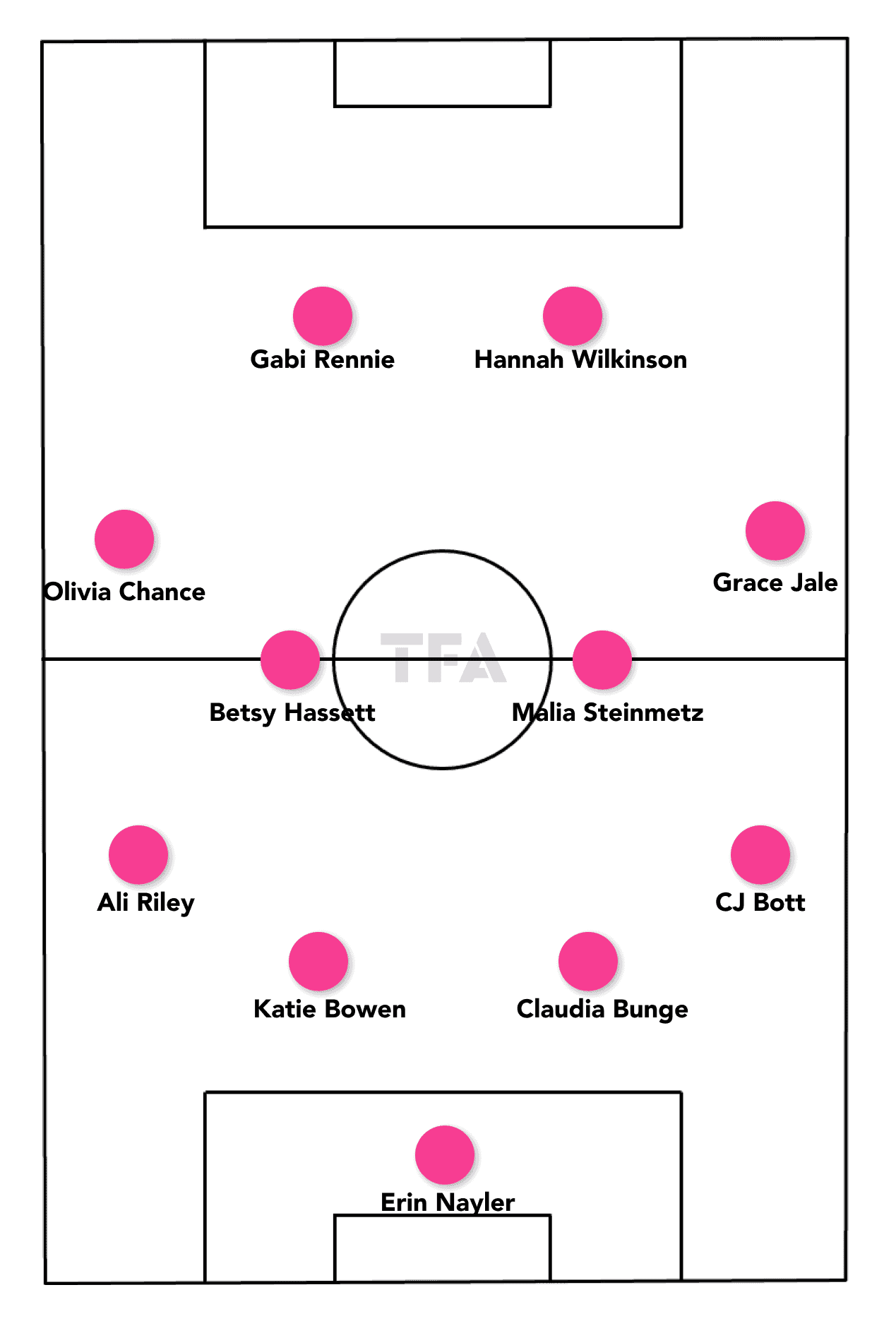
New Zealand are one of the few countries yet to name either a provisional or a final squad, so it is not yet known who will make the cut and who will miss out on a home World Cup.
However, predicting a starting XI should not be too difficult, given that there are several players who are almost certain to be included from the off. One of those is Norrköping’s Erin Nayler, who will be heading to her third World Cup and who is undoubtedly the first choice between the nets, with her proving throughout her career to be a safe pair of hands and someone that her teammates have great faith in to keep them in games. Rangers Women’s Victoria Esson has played a number of times in the last year, but Nayler is undoubtedly ahead of her in the general pecking order.
In the defensive line, the inclusion of Leicester City Women’s CJ Bott and captain and Angel City star Ali Riley at right and left-back are also fairly certain, but between them presents a couple of questions as there are a few combinations that could be selected. However, in this lineup, the pairing of Melbourne Victory Women’s Claudia Bunge and Melbourne City Women’s Katie Bowen have been selected, as they give New Zealand an ability to make last-ditch tackles and to play out from the back.
In order to facilitate those passes, the central midfield needs to contain players who are comfortable with the ball at their feet and whilst there are again a number of contenders, the duo of Western Sydney Wanderers Women’s Malia Steinmetz and Wellington Phoenix Women’s Betsy Hassett seems the most logical, as it allows them to both pass and dribble and adapt to different match situations.
On the wings, it is almost certain to be Canberra United Women’s Grace Jale and Celtic Women’s Olivia Chance who will get the nod, with the former demonstrating her pace throughout the 2022/23 A-League Women campaign and the latter a creative playmaker who will test opposing defences in different ways.
Finally, in the forward line, the partnership that head coach Jitka Klimková favours is that of Melbourne City’s Hannah Wilkinson and Arizona State Sun Devils’ Gabi Rennie, and it seems unlikely that the Football Ferns will stray from that now.
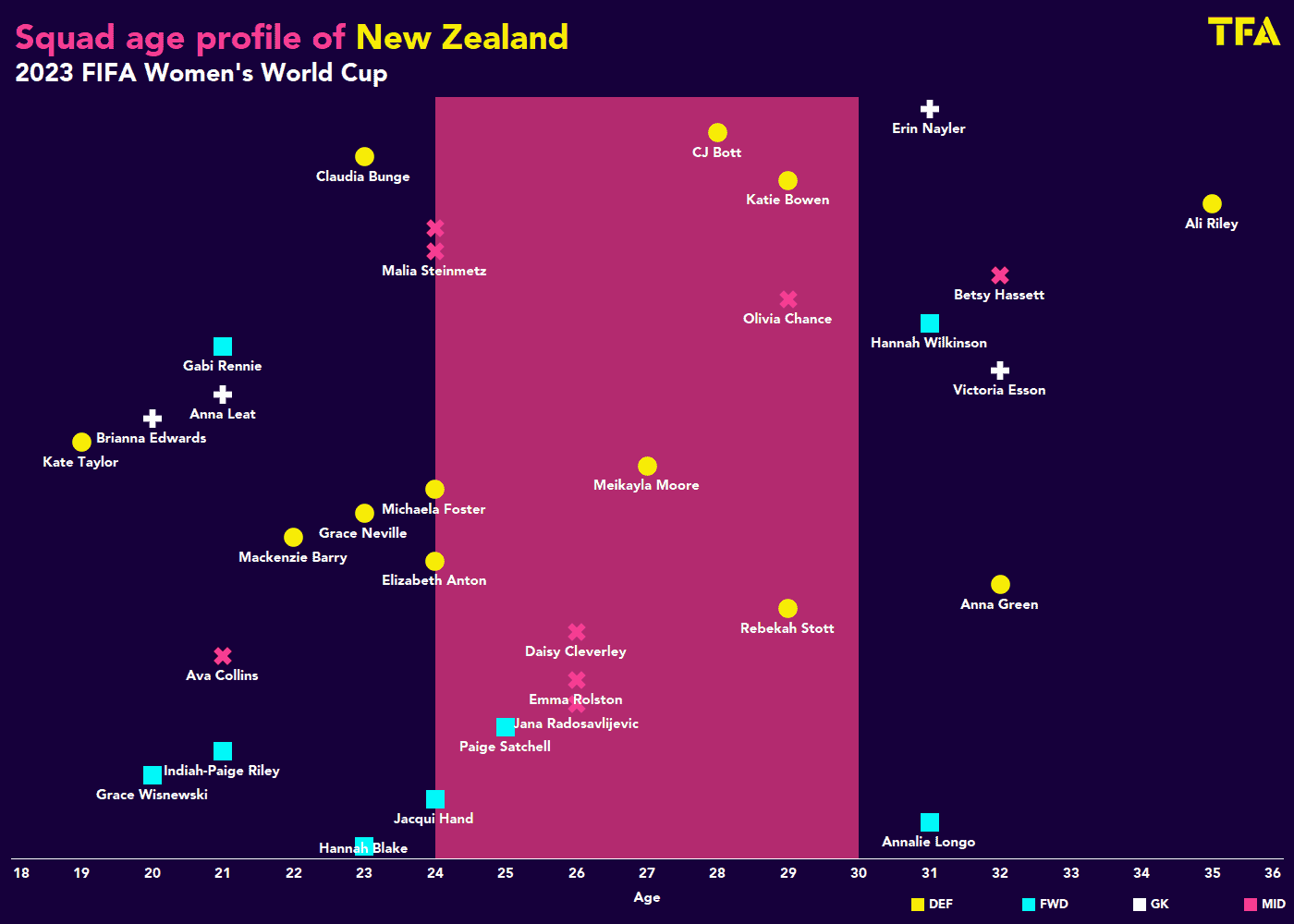
When looking at the spread of ages of those who are in with a chance of making the squad, it’s clear that there is a slight bias towards youth in the New Zealand squad, with many of their potential options either in the youth or peak sections of the chart. This suggests how the mentality around selecting the team is on bringing up the next generation of players and giving them chances to show what they can do where appropriate.
However, it is also important to note that the experience that can be so valuable in international tournaments is not forgotten, and it is telling that many of the players likely to feature heavily in the tournament are either in the latter stages of the peak area or are in the experience section of the chart. Therefore, there is a balance maintained in the squad, and that will be important in major events like this where mistakes simply cannot be afforded.
Attacking Phase
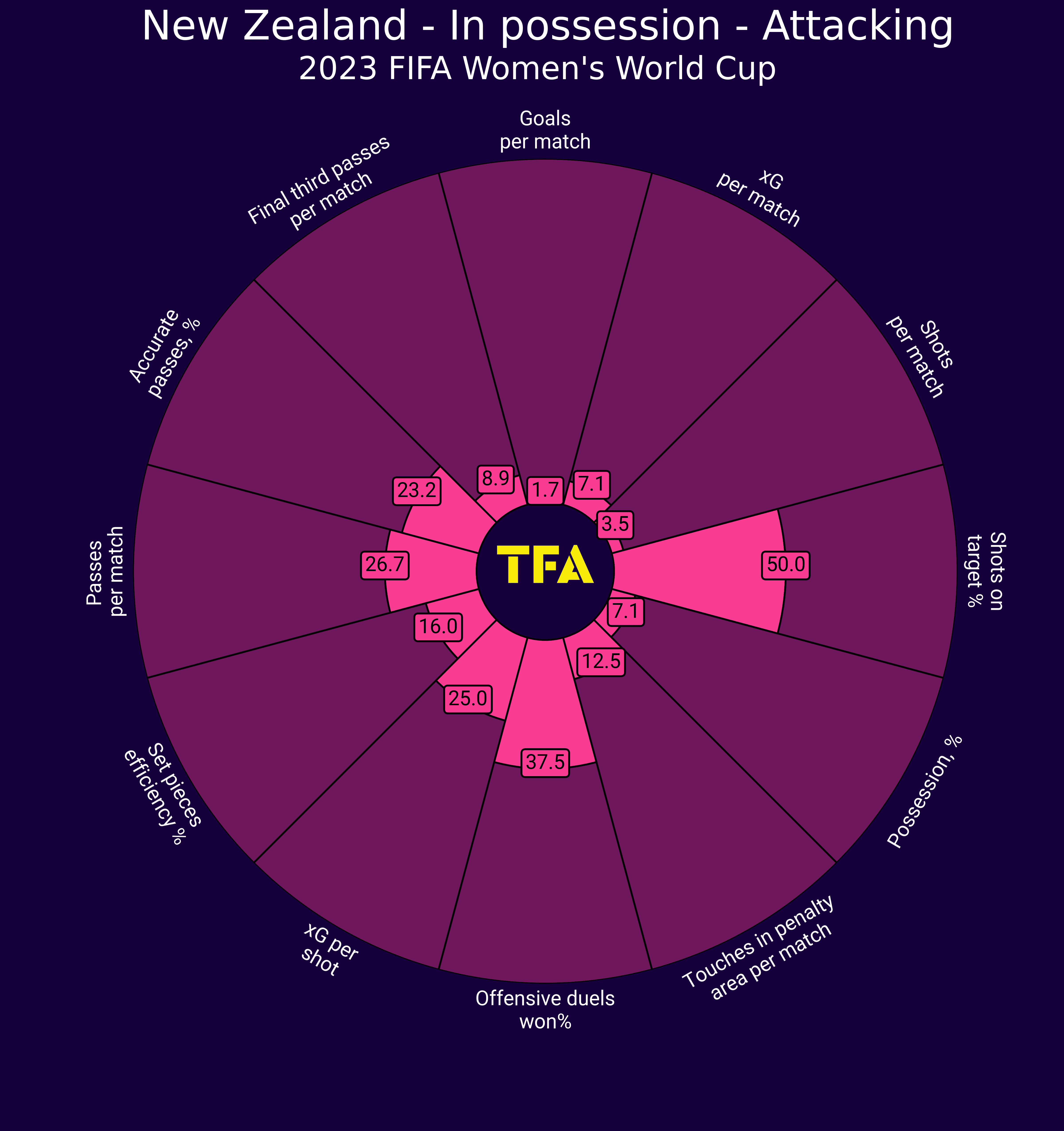
Turning now to how New Zealand play on the field, it has been clear to many that they struggle to create many opportunities during games and tend to live mostly on scraps, and that is highlighted in this graphic as most of their statistics are in the lower bands, indicating that, in percentile terms, they are among the lowest-performing sides at the World Cup.
However, it is not all negative and there are some aspects of this graphic that can give fans hope that their team can compete with their opponents. One of those is that despite their relatively low percentile ranking for shots on goal, they do sit among the median for those that end up heading on target. Therefore, on the occasions when they get into promising areas, they do manage to test opposing goalkeepers, and that shows how teams can’t take them for granted and will have to be eternally watchful of preventing them from advancing too far up the pitch.
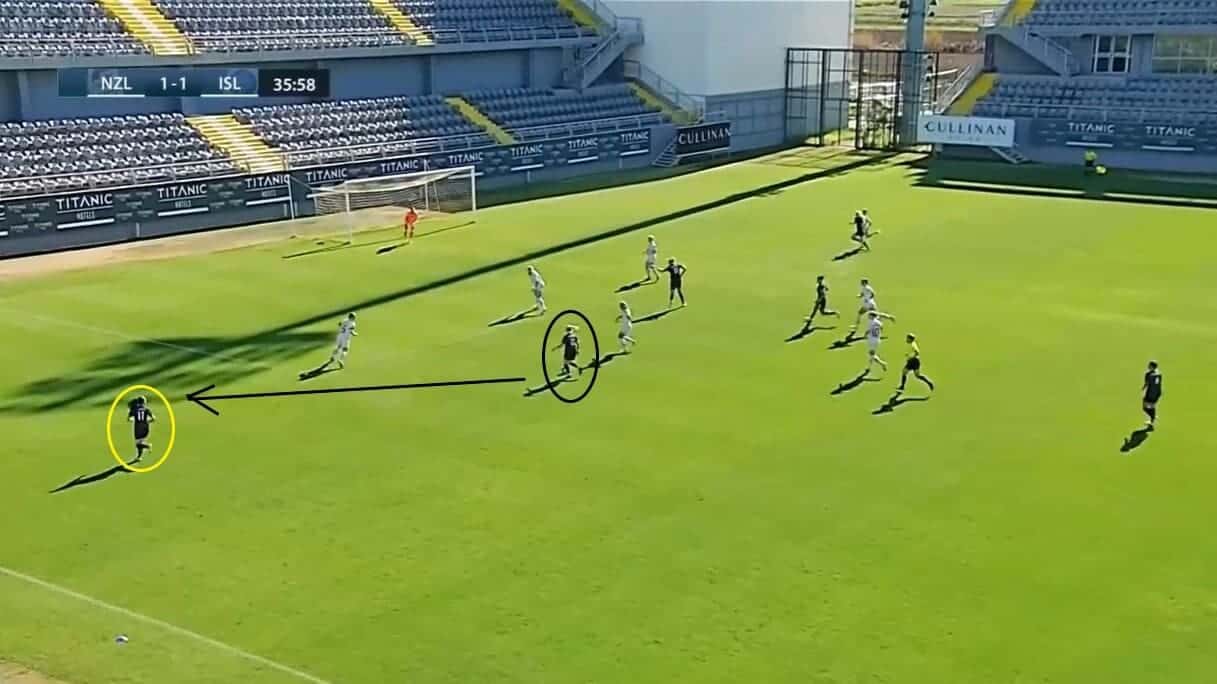
The player who is largely responsible for progressing the ball into advanced areas is Hassett, with her continually standing out in New Zealand’s games for her excellent control of the ball, ability to turn on the spot and composure under pressure.
That final point really comes into its own when she is making dribbles into dangerous areas, because she has a knack for holding onto the ball right up until the last second and forcing opponents to commit to coming out and closing her down, before transferring it into a teammate and allowing them to exploit the gap that has subsequently opened up.
This is highlighted here, with her waiting until the Icelandic players had narrowed up before passing out to Chance on the nearside wing, and the fact that this led to a shot on goal shows just how effective this can be in manipulating defences and setting up those shots on goal that New Zealand are generally very accurate with. Therefore, whilst Hassett doesn’t often attract the headlines during games, she will be a key player in the side and is someone that the Football Ferns would find it very difficult to play the same way without.
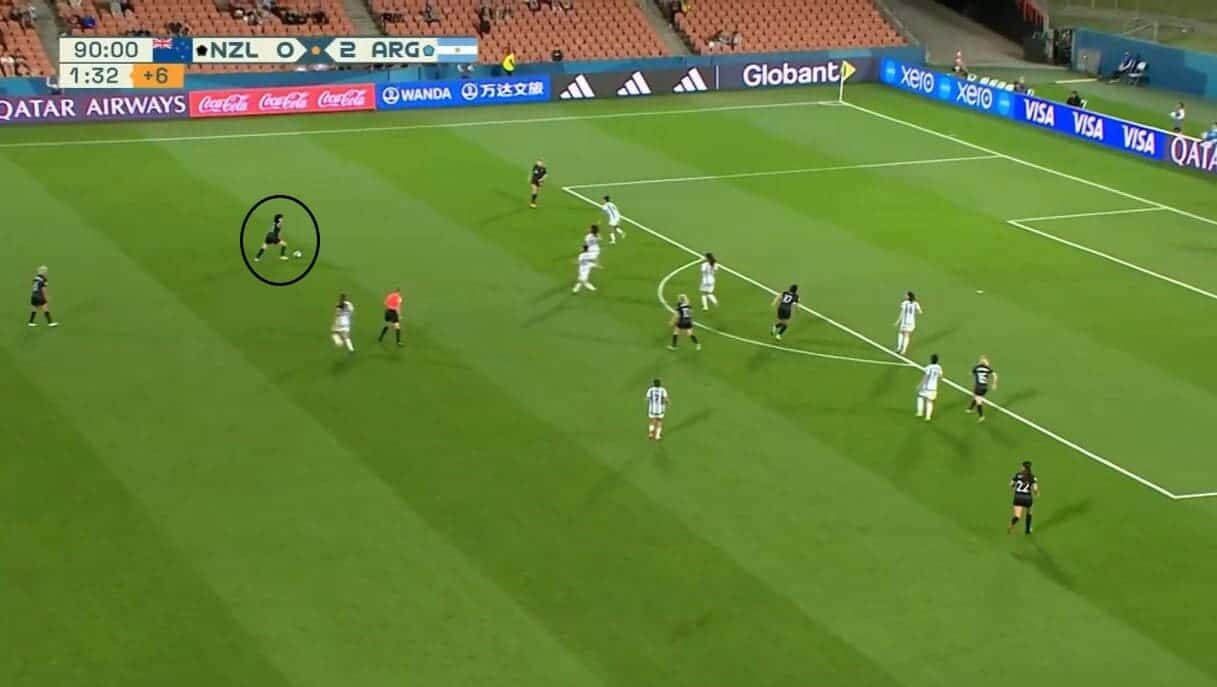
The other player who has a significant role in their play is Chance because, as mentioned earlier in the scout report, her strengths lie in the variety of things that she can do on the field. For Celtic, she has often been deployed as a 10 and has been given the freedom to link different areas of the team together. Even though she tends to act as a winger for her national side, there are still a lot of similarities in her game, such as her desire to cut inside and play in difficult areas to defend against and to both create and shoot at goal.
However, the key point to mention here is that she is winning a second ball, and with New Zealand’s forwards not often dropping back, it is vital that they have players in their midfield line who can offer this level of support in order to keep attacks alive. For Chance, her ability to make these runs is what allows her to get into the central areas, and the fact that she ends up shooting at Argentina’s goal here and narrowly missing the target indicates just how dangerous she is when players sit back and allow her to get into areas like this.
Therefore, as well as Hassett, Chance is another player that New Zealand will want to get into the game as much as possible, and opponents should pay special attention to this threat from deeper areas.
Defensive Phase
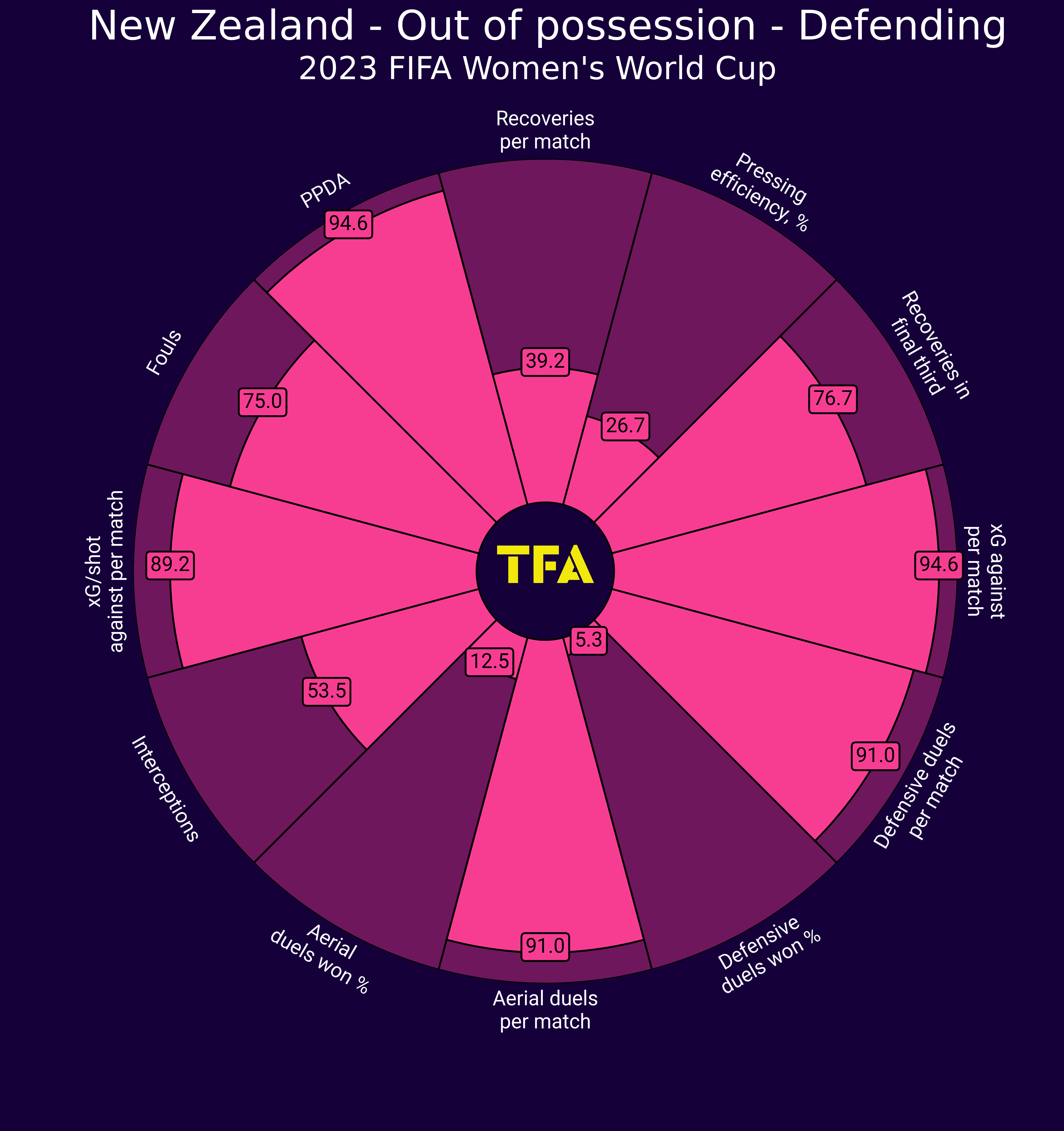
As mentioned, New Zealand have been on a very poor run of form, and that is reflected here through their defensive statistics. The thing that immediately stands out is that whilst they engage in plenty of defensive and aerial duels, they rank among the lower bands for those that they win which shows that whilst it is not down to effort and endeavour, they just don’t have the quality to keep teams out.
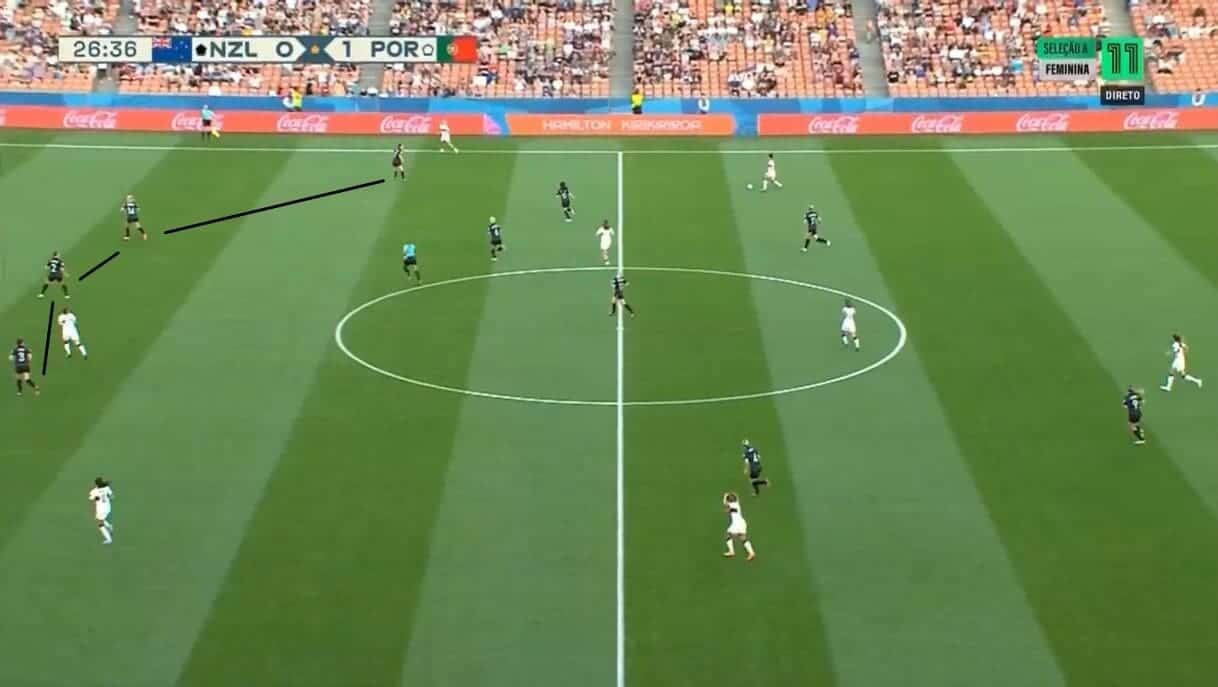
That endeavour is highlighted here because once they lose the ball, New Zealand do have a clear plan for how they want to defend their goal area and limit the progress that their opponents can make. It’s a very simple structure that they adopt, which sees their back four come together and then the player nearest the ball moves out to close it down whilst the others focus on the runs through the middle of potential passing options. The aim is to force the opposing side to either play sideways or backwards and lose their momentum.
In this case, the system can be seen clearly, with Riley, who played at left wing in this game but who has dropped back into defence at this point, pressing the ball as the trio of Bunge, Kate Taylor and Bowen have narrowed up to ensure that Portugal have no way of playing an early ball into the space behind them.
Whilst New Zealand ended up losing this game comfortably in the end, largely down to their own mistakes, moments like these showed that they can be tough to break down and can make it difficult for opponents to score against them — that is what they need to hold onto when the action gets underway.
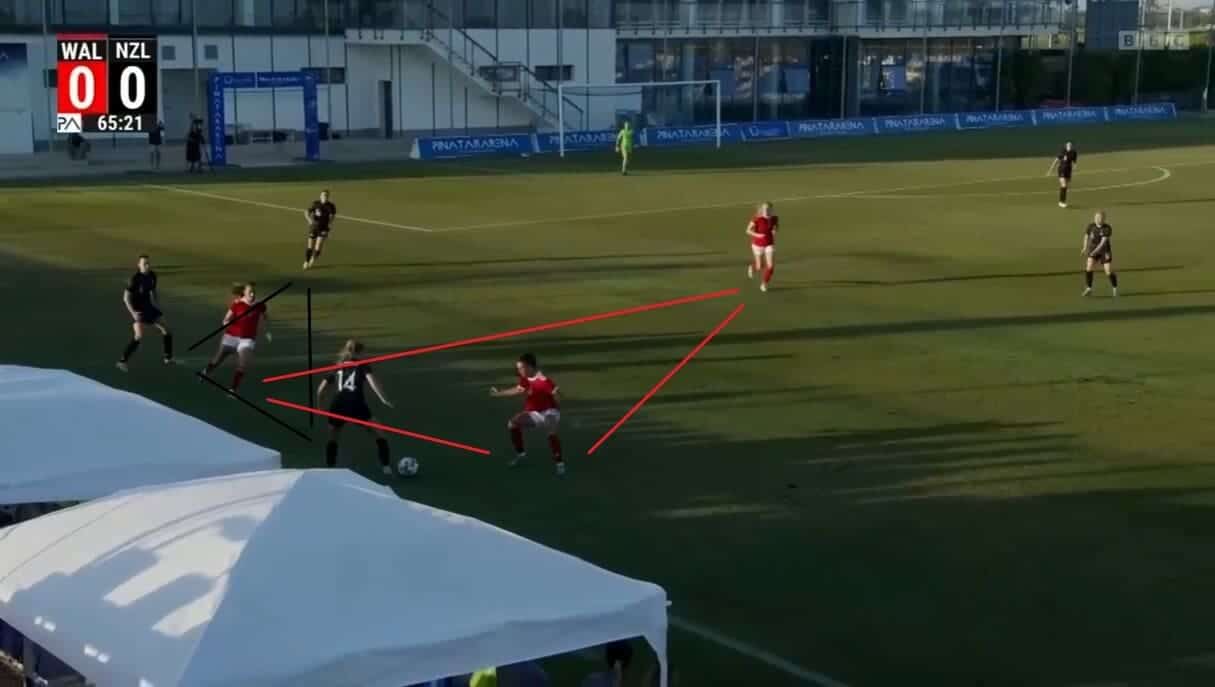
However, they can be too predictable at times, and that does land them in trouble as opponents work out ways to break their system down and capitalise on their subsequent mistakes.
In this case, New Zealand were looking to play out from the back and transferred the ball towards Bowen on the nearside of the wing. She has been instantly closed down by Wales duo Kayleigh Green and Ffion Morgan, so can’t turn and play forwards as she would have originally looked to do. As a result, she passes back to Taylor, which is where they fall into Wales’ trap and allow their opponents to intercept the pass and create a shot on goal, with Liverpool Women midfielder Ceri Holland, who is one of their key threats, setting up a shot on goal from this situation.
Therefore, whilst it is clear that New Zealand have a game plan which is commendable and clearly works when they have the time to set it up, it might be an idea to devise an alternative strategy, because what they can’t afford is situations like this when they play into their opponents’ hands and allow them to break their structure down.
Transitions
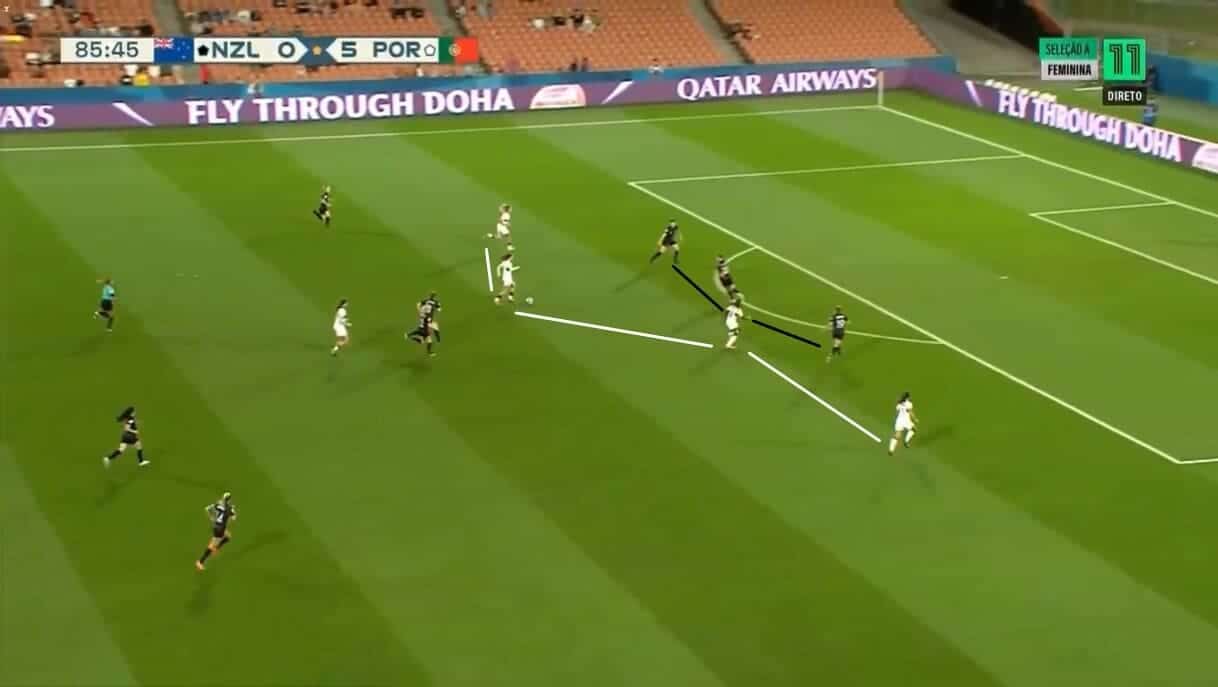
It is not just the player on the wing who can fall foul of that predictability, because there have also been occasions when opposing sides have recognised that the Football Ferns will have a compact back three as soon as they lose the ball, and have used that against them.
Portugal were one of those, with them constantly taking advantage of New Zealand’s mistakes and then pressing forwards to outnumber them inside their own third, with four players working together to cut off the three defenders from the rest of the team and ensure that they can use the spaces either side of them to create goalscoring opportunities.
In this case, once they had won possession, the ball travelled out to Benfica Feminino right-back Catarina Amado, who was able to shoot at goal. Even though her effort went across goal and wide, the fact that it came about at all indicates again how New Zealand only having one way of playing can get them in hot water.
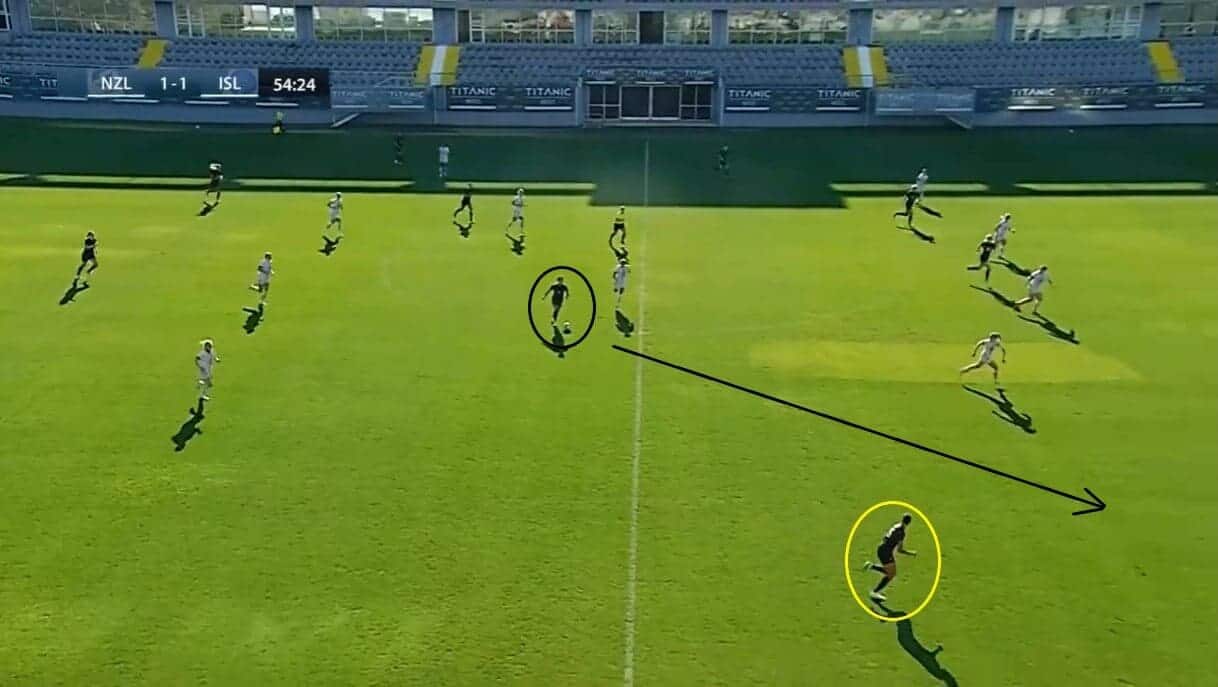
On those occasions when they do manage to play out from the back, though, they can pose a genuine threat, and it has already been mentioned how Hassett and Chance are key players in their tactics through the role that both play in creating opportunities.
However, the player who perhaps has the biggest role when it comes to their transitions is Steinmetz, with her often sitting deeper than the other two and providing the team with balance, and it suits her to be closer to the defensive line as her key qualities include ball control and clever identification of space.
Again, she is not a player who attracts the headlines, but she is a key cog in the Football Ferns machine. The fact that she takes just two touches of the ball here before feeding it into Jale’s path is really important to note, as it allows New Zealand to take the ball beyond the Icelandic defensive line and create a goalscoring opportunity.
It is worth noting that this was the draw mentioned in the introduction as the only game that New Zealand haven’t lost this year, and it was built on moments like this when they managed to get everything working and players were in tandem with one another. In short, if they can find a way to recreate the quality that they showed in this match, then they will have a chance of getting points on the board during their group games, and will certainly entertain their fans.
Defenders
There is no doubt that versatility is key when looking at what Klimková favours, with the fact that Riley can play as a full-back or a winger and Bowen can play at centre-back or left-back really aiding them in their quest to be included in the starting XI, largely because it allows them to switch around the pitch at will whenever they need to set up in their aforementioned defensive shape and have to adapt and move around to cover positions.
However, there are some who are not as versatile and who only specialise in one role, and yet that is not frowned upon and is actually useful to have on the bench, as it allows the team to change course when they need to be more solid if there are too many spaces being left open through positional rotations, so having players like Grace Neville, Elisabeth Anton and Meikayla Moore is vital as they can come in and plug gaps where needed, and that could be what makes the difference between a win and a draw or a draw and a defeat.
Midfielders
Whilst this scout report has identified Steinmetz and Hassett as the pair that provide the optimum blend of qualities in the central third, there are other names who could come in and stake their claim in the squad. One of those is HB Køge’s Daisy Cleverley, who has just won the 2022/23 Gjensidige Kvindeligaen title and who is a regular member of the national squad. She has started a lot of games in the last year and is a player that Klimková regards highly, so it would not be a surprise to see her go above either of the other two in the pecking order if there was a feeling that she was a better fit for the game plan.
On the wings, the main alternative to Jale and Chance is Paige Satchell, and the fact that she is more of a traditional winger than Chance could lead to the latter either being withdrawn during matches or switching to a central role in place of one of those inside her and allowing the Wellington attacker to come in and stay a little wider than Chance would.
Attackers
However, the wing is not the only role that Satchell could fulfil, with her also capable of operating in the forward line if needed and of making runs that stretch opposing defences out in the same way that Wilkinson and Rennie do at times, and it would not be a surprise to see her given some time in one of the two attacking roles at some point in the tournament.
On the whole, though, the forward line is not an area where New Zealand are blessed with a mass of options who can come in and make an immediate impact, with a lot of those likely to be the backup options still at the start of their international careers and yet to really establish themselves as regular squad members.
That is not always a bad thing, as it will make it interesting to see who Klimková introduces from the benches during the group games and to see who takes their opportunity when they are given them. However, it could be what undoes the Football Ferns in the end, given that attacking has already been shown to not be their forte.
Key Player
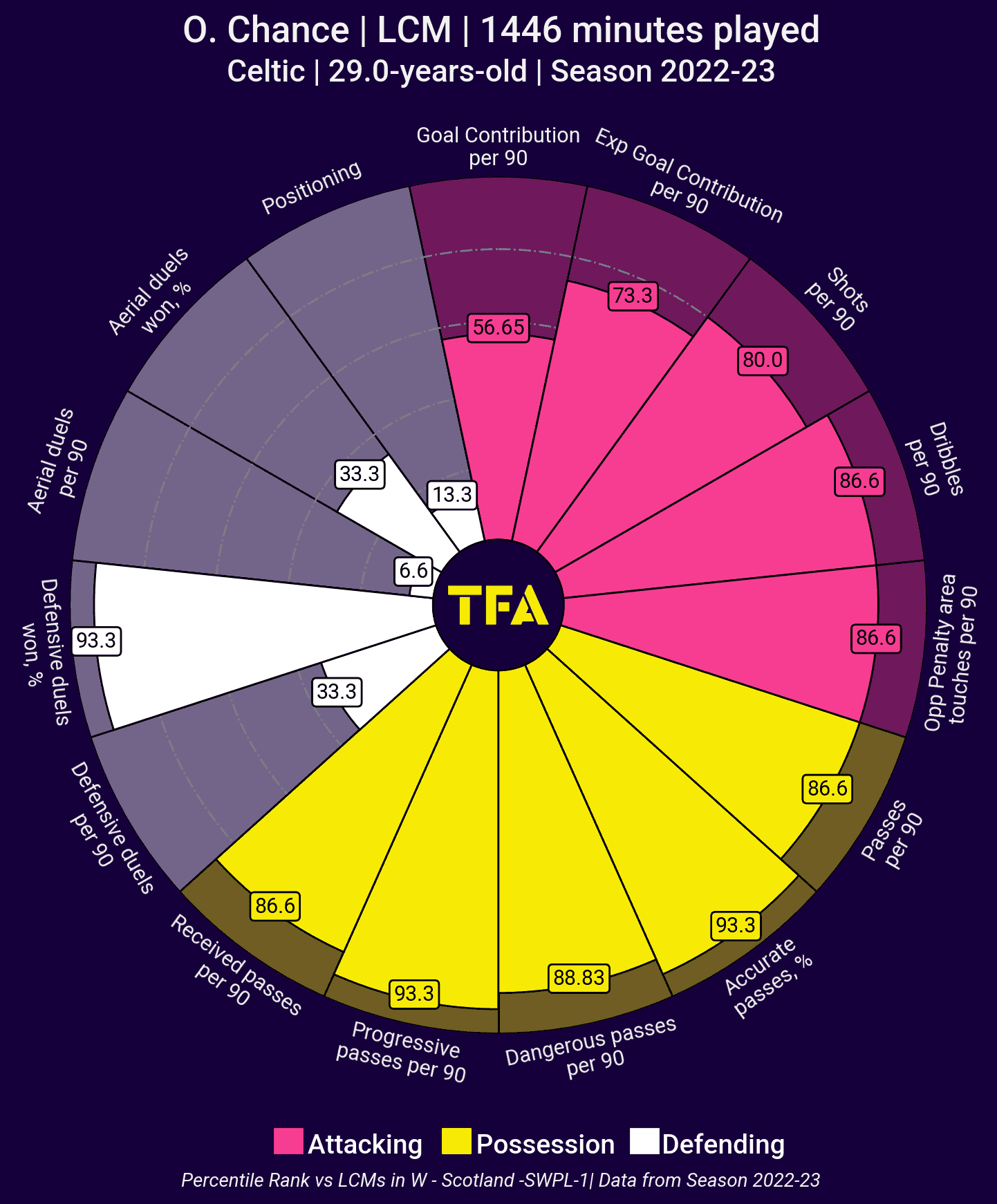
A great number of the potential New Zealand squad have been mentioned in this analysis, but there is only one that keeps cropping up as a game-changer: Olivia Chance.
Whilst Hassett’s ability to dribble forwards and keep the ball in tight spaces will be essential, and whilst Bowen’s ability to play out from the back will be key in helping the team to play on the front foot, Chance is the one who can make split-second decisions with regards to cutting inside or staying wide and shooting or finding a teammate, and the fact that she has such a large amount of freedom on the field will allow her to really be at her best during the World Cup.
When her team need someone to inject some energy into a match, she will be the one that they look to, and the fact that these statistics show how influential she was for Celtic in the last season means that there will be a lot of hope that she can replicate those displays for her national team over the next month.
Tournament Prediction
As has been hinted at throughout this analysis, New Zealand, despite being the tournament’s joint hosts, are not among the highly-fancied sides to advance far into the tournament. The fact that they have been dealt a harsh hand when it comes to their group, in that they will be up against Norway, Switzerland and the Philippines, means that many expect their run of not getting out of the group games to continue.
However, this is not to say that they are a bad team, as whilst they have had some poor results of late, it is clear for all to see that when they get every detail right, they are a handful and can be both robust and dangerous in the final third. Whether they can spark into life on home soil this summer is still an unknown, but their fans will hope that they have something to cheer when the action gets underway. For us, a third-place finish in their group would be a realistic result to expect.




Comments